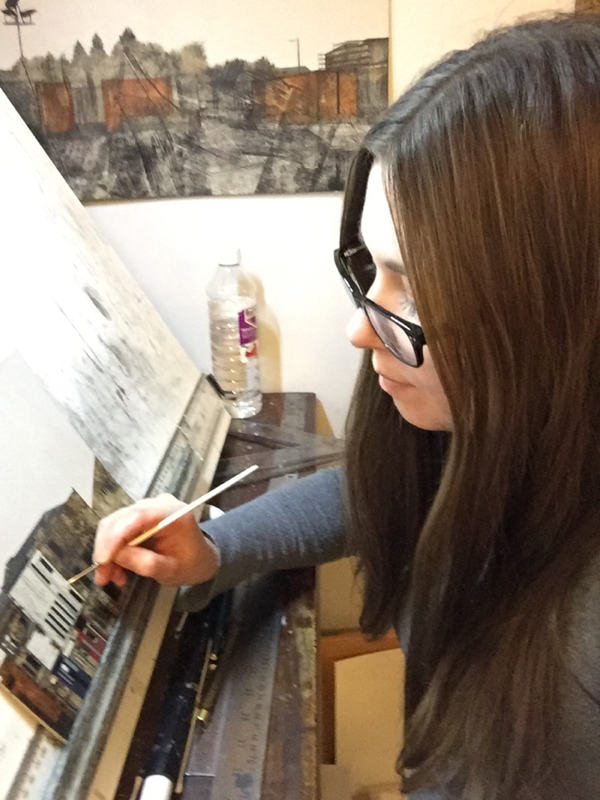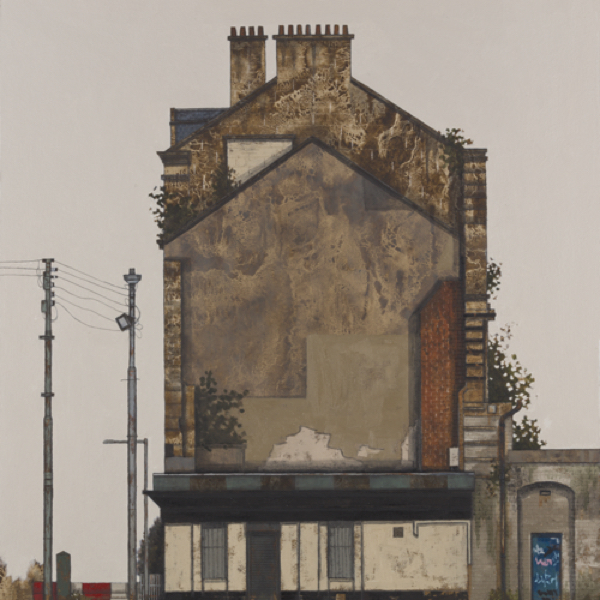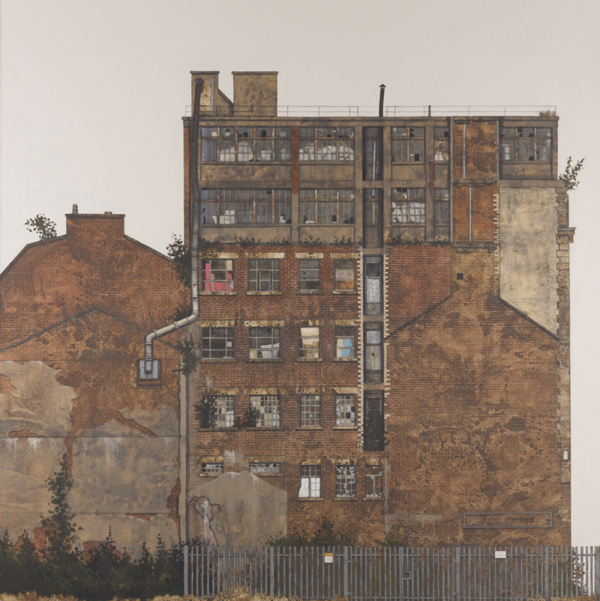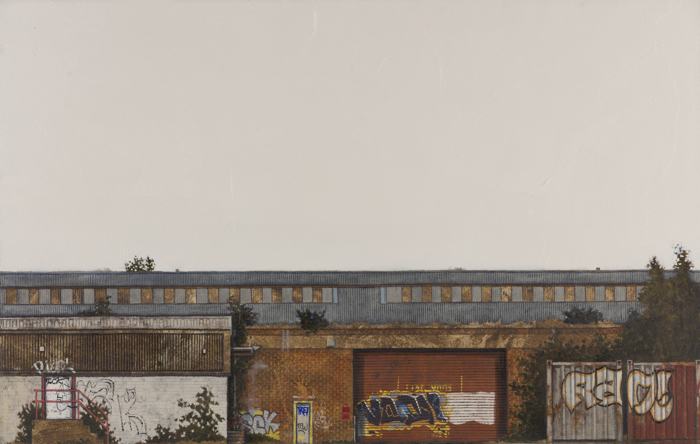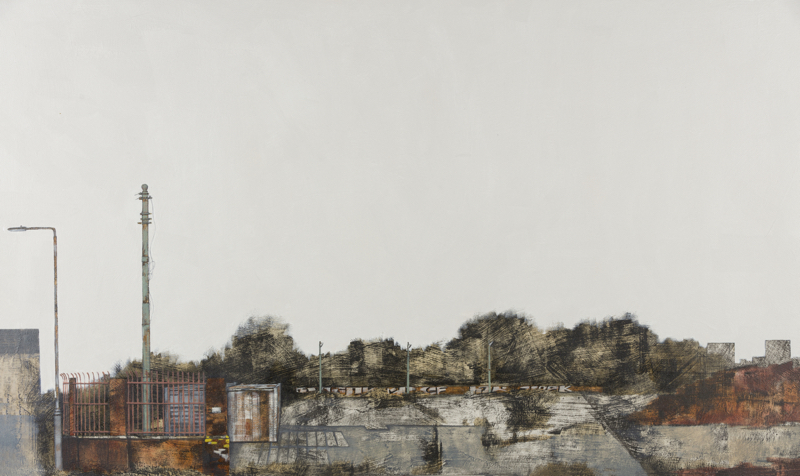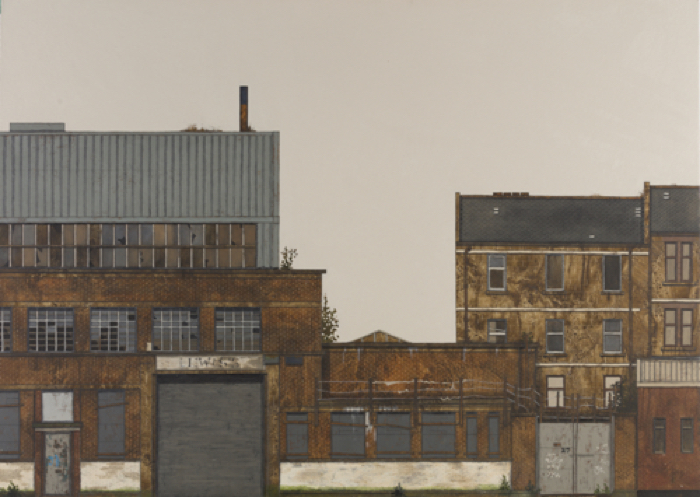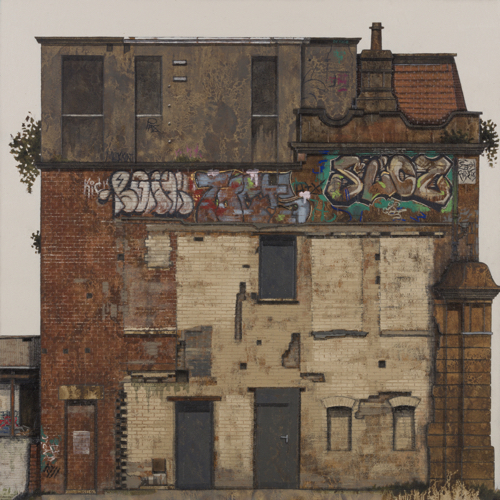What draws you to paint urban landscapes?
I have always had a fascination with architecture. The earliest memories I have are from when I lived in the Greenock area on the Clyde. The industrial nature of that place in the 70’s, with its cranes and shipyards, grand merchant buildings and the awesome, brick-built sugar sheds, made a lasting impression on me.
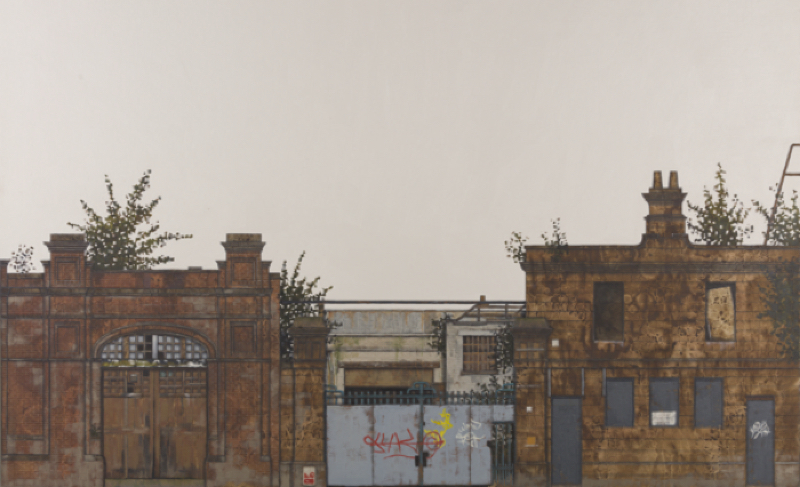
Entrances
Now living further up the Clyde in Glasgow, and witnessing the decline of these industrial spaces and structures, I am drawn to urban and post-industrial areas to document the disappearing and ever-changing landscape of these environments. As the architecture is overtaken by processes of nature and neglect, I am fascinated by the combinations of textures and colours in these urban environments – the peeling paint, rusting metal, greening concrete and decorative brickwork. Increasingly, I am drawn to heavily graffitied surfaces and enjoy the colour they bring to my often muted palette.
Deconstruct
You comment, “A key part of my process involves going on-site, to places I perhaps shouldn’t” discuss.
A lot of the places I do my urban exploration (urbexing) are often fenced off or boarded up as the buildings are derelict and deemed unsafe. So I say that I ‘perhaps shouldn’t’ because there is an element of risk at these sites and the public are not really permitted to access them. However, because it is the exterior of the these buildings that I am interested in, I take less of a risk than some of my fellow urbexers who venture inside.
Bridge Structure
Do you see your work as a historical reorder?
Although the majority of buildings I paint are historical, I see my work as capturing them in the present; as they are at the moment in time I discover them. I am unsentimental in the way that I portray the structures. My paintings are an honest representation of the reality I see in front of me. The buildings tell their own story.
Explain about the small details in your paintings.
Small details are intrinsic to my work. Every brick, every loose tile, every broken window and rusty drainpipe is painted in meticulous detail, because these are the elements that describe the age and deterioration of the building. I continue to develop techniques to render these effects on the different building materials. I have a lot of patience and am a
slave to accuracy, and find this painstaking work very enjoyable. How has lockdown affected your ability to visit sites to paint? Lockdown has had a huge impact on the way I have been able to work this last year. Due to an underlying health condition, I have been shielding for the most part and unable to leave my house. My creative solution was to turn to Google Street View to explore locations I had intended visiting. I had used it in the past as an additional resource, and although not as ideal as actually being there in person, and restrictive interms of the angles I could see, it was a good substitute in the circumstances. My latest Solo Exhibition was the culmination of this different way of working, created while juggling periods of homeschooling my young daughter.
Over Crowded
Explain on your award and membership of the Society of Scottish Artists in 2016.
In 2016 I was awarded Professional Membership of this highly respected arts body which was founded in 1891. It has a long history of championing contemporary Scottish art and its main exhibiting space is in the beautiful Royal Scottish Academy in Edinburgh. To gain Professional Membership you must be actively practicing in the visual arts. A body of work is peer-reviewed by other Professional Members of the Society and is only awarded to those that demonstrate talent and dedication in their chosen field. I was honoured to receive this endorsement of my practice and continue to show my work in their Annual Exhibition at the Academy where I have won several awards.
Department
How do you start the process, by photography or sketch book work?
Photography is my primary method of resource gathering. I have a particular way of photographing buildings to capture every detail, taking a series of shots of the elevations, then finding vantage points to photograph the roof and architectural features that can’t be seen from ground level. Each painting is drawn from a series of photographs of one side of the building. The preliminary sketches I do prior to draughting a painting are mainly to work out composition. The nature of finding my subjects in ‘out of bounds’ locations means that I don’t hang around long enough to get caught, so on-site sketching isn’t really a practical option.
Railway Sheds
Can you tell us how you decide on the angle you will paint either a building or group of buildings?
I think that one of the things that makes my work distinctive is that I paint my subjects like an architectural drawing. There is rarely any perspective in my work, instead I paint the elevations of the buildings in the same manner that the architect would draw the plans. I transpose the information I collect in my photographs into a perspectiveless view of
the entire side of the building, with everything at eye-level, and use shadows to describe the 3-Dimensional form.
Levelled Terminus 11, Monotype Series
Has there been a site that could almost be a series in itself?
Most sites I visit yield several paintings if they have good access. I often paint all the different sides of buildings individually creating a series of related paintings. I have several favourite locations that I return to time and again, to document how they have changed since my last visit. These include a group of derelict Victorian and 60’s railway sheds and
the area around the disused Graving Docks on the Clyde. There are also some fantastic locations in more built up areas of the city where I have done a lot of paintings of a group of buildings from each different side.
Clydeside
Discuss the sizes of your work and how you choose the size?
My work has been getting larger of late. I have been working on bigger supports than I have in the past, mainly because of the subject matter I am choosing and the level of detail within them. The sizes and shapes of each piece is dictated by the subject matter itself to some extent. Sometimes I like big skies and a further away viewpoint to give a sense of the emptiness of a location, and for others I choose to be very close up with very little space around the building to give the feeling of
crowded urban areas with buildings packed together, blocking out the sky.
Cross Section
Expand on the impact the horizon line has in your work.
As I described previously, unusually I don’t tend to use a horizon line in my work, preferring not to use perspective, but to treat each subject like an architectural drawing.
However, a few years ago I did create a body of monotype based work focussed around industrial wastegrounds – the places where buildings once were but had been demolished. This different subject matter required that I use perspective to describe the vast emptiness of the spaces, with the remaining disparate buildings that occupied the
perimeters of these sites. The low horizon line I employed for these works gave the feeling of an empty, bleak space – a place that once was a hive of industry, reduced to a concrete footprint with weeds coming through the cracks. It was an interesting exercise to play around with different viewpoints and change up my subject matter.
Feature Wall
Contact:
Cate Inglis
www.cateinglis.com
cateingliscom@gmail.com
Deborah Blakeley, Melbourne, Australia
Interview by Deborah Blakeley, August 2021
Think a colleague or friend could benefit from this interview?
Knowledge is one of the biggest assets in any business. So why not forward this on to your friends and colleagues so they too can start taking advantage of the insightful information the artist has given?
Other artists you may be interested in:


